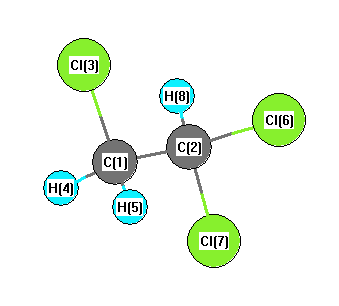Vibrational Frequencies calculated at HF/3-21G*
| Mode Number |
Symmetry |
Frequency
(cm-1) |
Scaled Frequency
(cm-1) |
IR Intensities
(km mol-1) |
Raman Act
(Å4/u) |
Dep P |
Dep U |
|---|
| 1 |
A |
3371 |
3043 |
1.06 |
|
|
|
| 2 |
A |
3356 |
3029 |
0.99 |
|
|
|
| 3 |
A |
3294 |
2973 |
3.31 |
|
|
|
| 4 |
A |
1636 |
1476 |
11.52 |
|
|
|
| 5 |
A |
1483 |
1338 |
5.92 |
|
|
|
| 6 |
A |
1447 |
1306 |
13.62 |
|
|
|
| 7 |
A |
1374 |
1240 |
23.37 |
|
|
|
| 8 |
A |
1327 |
1198 |
2.14 |
|
|
|
| 9 |
A |
1096 |
989 |
0.42 |
|
|
|
| 10 |
A |
1029 |
929 |
28.70 |
|
|
|
| 11 |
A |
829 |
748 |
21.14 |
|
|
|
| 12 |
A |
763 |
688 |
129.99 |
|
|
|
| 13 |
A |
702 |
634 |
32.92 |
|
|
|
| 14 |
A |
420 |
379 |
7.53 |
|
|
|
| 15 |
A |
356 |
321 |
0.78 |
|
|
|
| 16 |
A |
277 |
250 |
1.27 |
|
|
|
| 17 |
A |
199 |
180 |
4.88 |
|
|
|
| 18 |
A |
112 |
101 |
4.50 |
|
|
|
Unscaled Zero Point Vibrational Energy (zpe) 11534.5 cm
-1
Scaled (by 0.9026) Zero Point Vibrational Energy (zpe) 10411.0 cm
-1
See section
III.C.1 List or set vibrational scaling factors
to change the scale factors used here.
See section
III.C.2
Calculate a vibrational scaling factor for a given set of molecules
to determine the least squares best scaling factor.
Charges, Dipole, Quadrupole and Polarizability
Charges from optimized geometry at HF/3-21G*
Charges (e)
| Number |
Element |
Mulliken |
CHELPG |
AIM |
ESP |
| 1 |
C |
-0.487 |
|
|
|
| 2 |
C |
-0.432 |
|
|
|
| 3 |
Cl |
-0.042 |
|
|
|
| 4 |
H |
0.302 |
|
|
|
| 5 |
H |
0.298 |
|
|
|
| 6 |
Cl |
0.004 |
|
|
|
| 7 |
Cl |
0.023 |
|
|
|
| 8 |
H |
0.334 |
|
|
|
Electric dipole moments
Electric dipole components in Debye
(What's a Debye? See section
VII.A.3)
| |
x |
y |
z |
Total |
| |
-0.058 |
-1.547 |
-0.128 |
1.553 |
| CHELPG |
|
|
|
|
| AIM |
|
|
|
|
| ESP |
|
|
|
|
Electric Quadrupole moment
Quadrupole components in D Å
| Primitive |
|---|
| | x | y | z |
|---|
| x |
-57.726 |
-0.297 |
0.538 |
| y |
-0.297 |
-51.262 |
-0.467 |
| z |
0.538 |
-0.467 |
-49.268 |
|
| Traceless |
|---|
| | x | y | z |
|---|
| x |
-7.461 |
-0.297 |
0.538 |
| y |
-0.297 |
2.235 |
-0.467 |
| z |
0.538 |
-0.467 |
5.226 |
|
| Polar |
|---|
| 3z2-r2 | 10.451 |
|---|
| x2-y2 | -6.464 |
|---|
| xy | -0.297 |
|---|
| xz | 0.538 |
|---|
| yz | -0.467 |
|---|
|
Polarizabilities
Components of the polarizability tensor.
Units are
Å
3 (Angstrom cubed)
Change units.
| |
x |
y |
z |
| x |
8.809 |
1.049 |
-0.536 |
| y |
1.049 |
7.179 |
0.072 |
| z |
-0.536 |
0.072 |
4.669 |
<r2> (average value of r
2) Å
2
| <r2> |
0.000 |
| (<r2>)1/2 |
0.000 |
